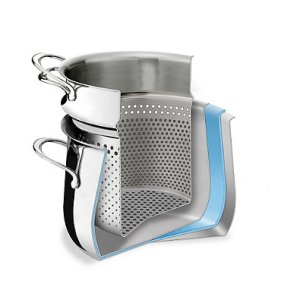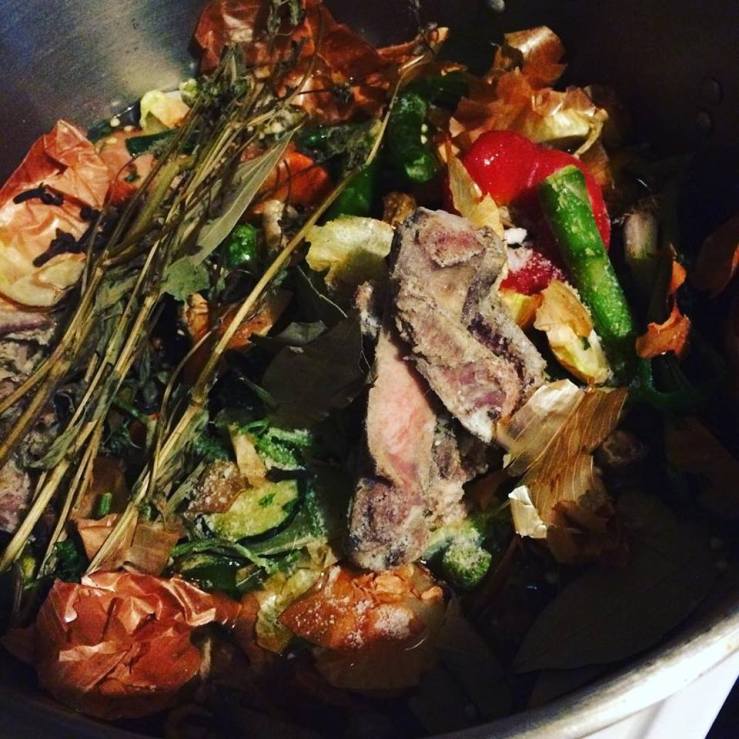I get asked a lot about making stocks. probs because I post a lot of pictures to the social medias like this:
with the caption “stock day!!!”
and this:
with the caption “stock day!!!”
and this:
with the caption “stock day!!!”
and many more, but I’m sure you get it.
stock days make me happy because my house smells so good and I’m making something delicious, but I actually mean that it’s bouillon day because I have zero space to store stock.
bouillon isn’t hard. it’s a bit time-consuming. most of it doesn’t require babysitting, and it’s so worth it because it costs nothing beyond time and energy, it tastes far better than anything you can buy at the store, you can use up stuff that would otherwise end up in landfill or compost, you have full control over what goes into it (*cough* sodium *cough*), and you can whip up a tastes-like-homemade (because IT IS) soup in half an hour when you have it on hand.
I shit you not, I made this in half an hour tonight (and I’ll teach you how another time):
it’s also handy for all kinds of other things (I’m lookin’ at you, risotto and stew and gravy and casseroles and…I’m lookin’ at a lot of you delicious things).
this is going to be way more a tutorial than a recipe because the whole shebang does require a certain amount of forethought, but there is a kind of proper recipe at the bottom and I won’t be offended should you like to skip (CTRL + F “seventh”) to that.
thing the first: the big bag o’ ingredients
I do not purchase ingredients to make my stock/bouillon. instead, I keep almost all that I might otherwise discard of the vegetables and fruits ends, tips, skins, and the rest that I use cooking other meals.
I like to use the great big brown bags from the LCBO (which may say a thing or six about my drinking habits) because, even though I make a stock at least once a month, those bags prevent things from getting all weird with ice crystals in between times.
when I’m making a meal, bringing out the bouillon bag is one of the first things I do. I put it beside where I’m chopping and toss in all of the bits as I go.
thing the second: what goes in the bag
as I said, almost everything goes in that bag and you can see as much from the pictures above.
reminder: they’re ALL SCRAPS. shit you would throw in the composter.
the major contenders are:
- parsley/cilantro – and any manner of herb leftovers (fresh dill, tarragon, basil, thyme, rosemary ends/stems), but parsley and cilantro are basically vegetables in our home, so they’re the mainstays
- tomatoes
- onions – I’ll talk more about those later
- carrots
- celery
- broccoli
- peppers
- mushrooms – those woody shiitake and oyster mushroom stems are amazing bouillon heavy-lifters
- citrus fruits – including peels. just juiced a lemon or a lime? toss the remnants in your bouillon bag
- ginger
thing the third: what DOES NOT go in the bag
there are some things that just don’t work. not many, but some and they mostly don’t work because they make things bitter. if you like bitter, then have at ’em.
the major contenders are:
- avocado bits
- eggplant bits
- unwashed potato bits – I don’t really like potato bits in mine anyway because they can muck things up with their starchiness, but unwashed bits make things dirty
if you know of others, please pass them along!
thing the fourth: dem bones
making stock/bouillon is a great way to make use of bones leftover from roasts and such.
DO make sure to store your bones in the freezer in a separate container from your regular stock bag of compostables. this way, you’ll avoid cross-contamination (especially if your compostable bag is in and out of the freezer for each meal like mine is) AND you have the option to make your bouillon meatless or meatful…or BOTH.
I put away most bones that come through the kitchen, but things like shrimp shells, fish and poultry skins, and pork and beef fat ends can also make their way into the pot. fish bones can be good, too, but be sure to have a really good strainer before considering them.
thing the fifth: flavour
the big thing I get asked is “how do you get it so flavourful”?
I said we’d talk about onions again and here we are.
onion skins give a broth fantastic flavour and colour. other alliums, like scallions, leeks, chives, and the rest help out, too, but you can’t do much better for flavour and colour than your average yellow cooking onion.
my bouillon bag consists of 40% onion skins because, yes, we do go through that many.
all of the “fresh” stuff is compost fodder, but I also use herbs and spices; bay leaves, cloves, nutmeg, black pepper, sage, and tarragon are my go-tos.
to the last bouillon I made, I added star anise, cumin, coriander, and bones leftover from a ham. it came out rather Phở-esque and lovely, but not necessarily the right thing for a classic chicken noodle soup. I do tend to stick to pretty “neutral” (westernly) flavours, but use your imagination and think about the dishes you’ll want to create with your bouillon when deciding on flavours.
I add about 2 teaspoons of salt to every stock because that’s what you do, but I have no scientific rationale for adding salt. I don’t think you need to. I just do it because tradition. I’ve made perfectly cromulent bouillons without it because I forgot to add it.
let’s not confuse with salt with flavour. salt is not flavour. suck it, salt.
thing the sixth: the tools
I maintain that it’s not worth it to make bouillon until that great big LCBO bag is full to bursting, so an 8 quart pot is my minimum. I swear by my trusty pasta pot that I picked up at a liquidation joint for about $17 a million years ago (ok, more like 16 years ago). the kind with the strainer insert that looks a bit like this:

…but, ya know, whole…and not $250. one does not require precision cookware to boil pasta or make bouillon.
you can make bouillon with a large pot and a decently-sized colander, too, but a pasta pot with a strainer is the perfect tool.
and a word about straining: I don’t feel the need to strain more than through the pasta strainer insert (or colander) unless I’m trying to for something super-fancy, which I am usually not. when I am, I usually make a much fancier stock. perhaps I’ll get into that in another post.
you’ll also need a goodly-sized vessel to strain your stock into (if you don’t have a pot with a strainer insert) and a wooden spoon.
thing the seventh: the nitty gritty
ok, here’s as close to a recipe as you’ll get from me for bouillon.
what you need:
- bones (or not – totes optional)
- enough compost tucked away in your handy-dandy bouillon bag to fill your pot (or strainer insert)
- water
- salt (or not)
- 2 tsp nutmeg
- 1 tsp cloves (you can use ground, but I prefer to just bruise whole cloves with the mortar and pestle)
- 1 tbsp ground black pepper
- 5 bay leaves
what you do:
- if you’re using bones, place them in the bottom of your pot (or strainer insert) (I know in the pics my bones are sticking out – the only reason I mention this first is because I all too often run out of room for bones after I’ve added the compost and I have to awkwardly shuffle things around and I’m trying to save you from my mistakes).
- fill your pot (or strainer insert) with the contents of your bouillon bag.
- fill the pot (with strainer insert) with water to 2 inches below the rim.
- add the remaining ingredients.
- bring to a boil over high heat.
- reduce to medium heat.
- use a wooden spoon to push any ingredients not covered by water into the water. if they don’t all get in, don’t worry about it.
- check on it periodically to give it a stir and add enough water to bring the liquid levels back up to keep the contents just covered.
- repeat until it has simmered for at least 2 hours for a plants-only stock and 3-5 for one with bones.
- strain.
- rinse the pot and return the strained liquid (without the strainer, if you’re using one) to it.
:::choose your own adventure time:::
- at this point, you have three choices:
- YOU CAN call it a day and call this a stock.
- OR YOU CAN let the stock cool if you’ve used any meat products in it and you don’t want the fat it brings to the party. in this case, you’ll want to toss the pot into the fridge for a few hours (overnight is awesome because then you’re sleeping and not thinking about delicious bouillon), skim and discard the fat that has risen and cry a little, and then move onto the next option.
- OR YOU CAN boil that shit down! I almost always opt for this because I have the patience of a puppy on speed and enjoy that lip-smacking fattiness. also, fat becomes a different thing in a bouillon than in a straight-up stock. it gets kinda magical. definitely use this option if working with a plant only stock…because no fat…so…yeah…move on to step the next.
- over high heat, bring the stock to a boil, stirring regularly, until it’s reduced…well…to a bouillon. BE CAREFUL NOT TO BURN IT. you can tell it’s done when it coats the back of a metal spoon like maple syrup does. you’ll likely have no more than 3/4 to a cup of bouillon…possibly less.
- remove from heat and chill until cold and kinda jelly-like.
- cut into bouillon-like squares or just spoon it into a container (I find those little ricotta cheese containers to be just the right size).
- toss it in the fridge for up to one month or into the freezer forever (except not because I’m sure you’ll use it all within a week).
- use 1-2 tsp of bouillon per cup of water/liquid (it really kind of depends on what you’re making) to go forth and make great things with it!
















You must be logged in to post a comment.